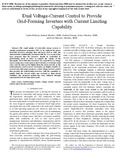Dual voltage-current control to provide grid-forming inverters with current limiting capability
Fecha
2021Versión
Acceso abierto / Sarbide irekia
Tipo
Artículo / Artikulua
Versión
Versión aceptada / Onetsi den bertsioa
Identificador del proyecto
Impacto
|
|
10.1109/JESTPE.2021.3133806
Resumen
The rapid uptake of renewable energy sources is causing synchronous generators (SG) to be replaced by power electronic inverters meaning these inverters need to offer the characteristics traditionally associated with SG. As a result, it has been proposed that the inverters should be controlled in grid-forming mode in order to support the voltage of the microgrids. Given that these inverters are c ...
[++]
The rapid uptake of renewable energy sources is causing synchronous generators (SG) to be replaced by power electronic inverters meaning these inverters need to offer the characteristics traditionally associated with SG. As a result, it has been proposed that the inverters should be controlled in grid-forming mode in order to support the voltage of the microgrids. Given that these inverters are controlled as a voltage source, temporary events such as short-circuits or overloads could cause currents that are far higher than the rated current. As the semiconductors used in power electronics are highly sensitive to overcurrents, this paper proposes a dual voltage-current control that provides the grid-forming inverters with the capability to quickly limit the current under any overload or short-circuit condition. The proposed method has been validated through experimental tests in stand-alone mode. [--]
Materias
Current control,
Grid-forming control,
Overload,
Short-circuit,
Voltage control
Editor
IEEE
Publicado en
IEEE Journal of Emerging and Selected Topics in Power Electronics, 2021
Departamento
Universidad Pública de Navarra. Departamento de Ingeniería Eléctrica, Electrónica y de Comunicación /
Nafarroako Unibertsitate Publikoa. Ingeniaritza Elektrikoa, Elektronikoa eta Telekomunikazio Ingeniaritza Saila
Versión del editor
Entidades Financiadoras
This work hasbeen supported by theSpanish State Research Agency (AEI) under grantPID2019-110956RB-I00/AEI/10.13039/501100011033, and by the Public University of Navarre through a doctoral scholarship.






